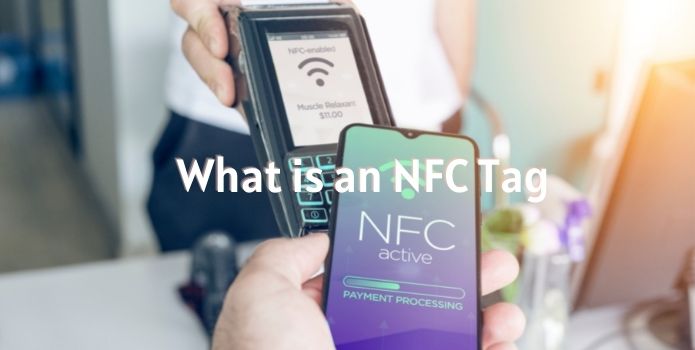If you think of wireless communication, NFC comes to mind. But what is NFC? NFC, or 근거리 무선 통신, is a short-range wireless communication technology that allows two devices to exchange data when they are close to each other.
At the center of this technology is NFC tags. These are special chips that can be embedded into products, packaging, or posters to enable them to communicate with NFC-enabled devices. We look at how NFC tags work and how you can use NFC Tags.
What is an NFC Tag and What Does It Do?
NFC tags are small memory-containing chips that can store a small amount of data, such as a URL or contact information. The data is primarily stored in Near Field Communication Data Exchange Format (NDEF).
This format allows for data transfer between two compatible devices. The receiver will decode the data and take the appropriate action, such as opening a website or adding a contact to their address book.
Several elements of the tag aid this communication. They work synergistically to enable a device to read the data on an NFC tag. They include:
- An NFC 칩. This is the smallest and most central component of the tag. It contains the data storage and processing capabilities of the tag. The chip comes with different memory sizes, depending on the application for which the tag will be used.
- An NFC Antenna. This is a flat coil of wire that enables the tag to communicate with an NFC-enabled device. The antenna can be made of different materials, such as copper or aluminum.
- 기판. This is the base material on which the other two components are placed. It can be made of different materials, such as paper or plastic. It is critical since it provides structural support to the tag.
How Does an NFC Tag Work?
An NFC tag has a simple working principle. It uses electromagnetic induction to enable communication between the tag and an NFC-enabled device.
When the two devices are close to each other, an electromagnetic field is generated. This field powers the tag and enables it to communicate with the NFC-enabled device.
The tag uses this power to send data to the device. In turn, the device decodes the data and takes the appropriate action.
In summary, the working principle of an NFC tag is similar to that of a radio. It uses electromagnetic waves to communicate data between devices.
However, the NFC tag has a shorter range than a radio. It can only communicate with devices that are close to it, typically within 10 centimeters.
Requirements for NFC Tags Functionality
For NFC tags to work optimally, you need three things:
- An NFC-Enabled Device
This is the device that you want to use to read or write data on the tag. The most common NFC-enabled devices are smartphones. However, not all smartphones are NFC-enabled.
So, how do you know if your smartphone is NFC-enabled? You can check compatibility by navigating to the phone’s settings, and under the “Connections” or “Network & Connectivity” section, look for NFC. If you can’t find it, then your phone is not NFC-enabled.
- An NFC Reader
An NFC reader is a device that can read/ write data on an NFC tag. The most common NFC reader is the smartphone. As we mentioned earlier, not all smartphones are NFC-enabled.
If you have an NFC-enabled smartphone, you can use it as an NFC reader. You can also buy a dedicated NFC reader. These devices are available in different form factors, including:
- Portable NFC Readers. These are handheld devices that you can carry around with you. They come in different shapes and sizes, and with different features.
- Fixed NFC Readers. These are designed to be mounted on a surface, such as a wall or a countertop. They are usually larger than portable NFC readers and have more features.
While dedicated NFC readers are becoming more common in retail stores, users still prefer to use their smartphones. This is because most people always have their phones with them.
- An NFC Tag
As earlier mentioned, an NFC tag is a tiny chip with an antenna that you can attach to an object. You can write any type of data on the tag, including URL addresses, contact information, or Wi-Fi passwords.
You can buy blank NFC tags and write your data on them using an NFC-enabled device. You can also buy pre-programmed tags. These are tags that come with data already written on them.
The most common type of pre-programmed NFC tag is TecTile. However, these tags can be quite expensive, and you can only use them with specific applications.
How to Use an NFC Tag?
With NFC tags, you can do all sorts of things. For example, you can use them to launch an app on your phone or to make a contactless payment. Here is a detailed look at how to use NFC tags:
How to Use NFC Tags with Your Phone?
If you want to use NFC tags with your phone, the first thing you need to do is to check if your phone is NFC-enabled. As we mentioned earlier, not all phones have this feature.
Once you’ve confirmed that your phone is NFC-enabled, you need to install an NFC app. This will enable you to read and write data on the tags.
There are many NFC apps available on the Google Play Store/ App Store. However, we recommend NFC Tools, NFC Task Launcher, and NFC TagWriter by NXP. These apps are free and easy to use.
Once you’ve installed the app, open it and tap on the “Write” option. Then, select the type of data you want to write on the tag. For example, you can select “Text,” “URI,” or “Contact.” After that, hold your phone close to a blank tag, and the data will be written on it.
Now, let’s say you want to launch an app on your phone using an NFC tag. For example, you can place the tag on your door, and when you tap your phone on it, the alarm clock app will stop.
To do this, open the NFC Tools app and tap on the “Task” option. Then, select the “Application” option and choose the app you want to stop (Clock/Alarm). Finally, hold your phone close to the tag, and the task will be completed.
After that, place the tag on your door, and when you tap your phone on it, the alarm clock app will stop. This is a sure way to stop you from snoozing your alarms!
How to Use NFC Tags without a Phone?
If you don’t have an NFC-enabled phone, you can still use NFC tags. For this, you’ll need an NFC reader. This is a device that can read and write data on NFC tags.
Use the reader to write data on the tag. Then, you can place the tag on any object, and when someone taps the reader on it, the data will be transferred to their phone.
If you want to read the tag yourself, you will just use the reader and the data will be displayed on the screen.
What are the Uses of NFC Tags?
- 비접촉 결제
If you’ve visited a retail store lately, you might have noticed that some of them allow you to make contactless payments. This is possible with the help of NFC tags.
In this case, the tag is usually placed on the POS (Point of Sale) terminal. When you tap your phone on it, the payment will be processed.
This is a convenient way to make payments, and it’s also more secure than using a credit or debit card.
Fortunately, most phone manufacturers are now incorporating NFC chips in their devices to make contactless payments possible. A good example is the Android Pay and Samsung Pay apps.
- Digital Business Cards
If you’ve ever been to a networking event, you know how important it is to exchange business cards. However, this can be quite a hassle, especially if you run out of cards.
With NFC tags, you can store your digital business card on the tag and share it with others by just tapping your phones together.
This is a great way to exchange contact information, and it’s also more eco-friendly than using paper business cards.
- Smart Home Automation
If you want to automate your home, NFC tags can be very useful. For example, you can place a tag on your door, and when you tap your phone on it, the door will unlock.
You can also use NFC tags to control your smart home devices. For example, you can tap your phone on the tag to turn on the lights or play music.
There are endless possibilities when it comes to using NFC tags for smart home automation. It all depends on your imagination!
- Data Sharing
You can use NFC tags to share data with others. For example, you can store a photo, video, or document on the tag and share it with others by just tapping your phones together.
This is a great way to share files without using Bluetooth or WiFi. It’s also more secure than using these methods since the data is transferred directly between the devices without going through a third-party server.
What are the Benefits of Using NFC Tags?
- Highly Versatile. NFC tags are flexible, and you can use them for a variety of purposes. This versatility makes them attractive for businesses and individuals alike.
- Guaranteed Convenience. NFC tags eliminate the hassle of manual work. You can use them to automate various tasks and processes.
- Increased Efficiency. NFC tags can help you save time and increase your productivity. For example, if you’re using NFC tags for contactless payments, you don’t have to fish your wallet out of your pocket every time you want to make a purchase.
- Better Customer Experience. NFC tags can improve the customer experience. For example, if you’re using NFC tags for digital business cards, your customers will appreciate the convenience and they’ll be more likely to do business with you in the future.
- Increased Security. NFC tags offer increased security compared to other methods. For example, when you use an NFC tag to unlock your door, only your phone can be used to open the door. This makes it difficult for intruders to break into your home.
- 저렴한 비용. NFC tags are very affordable, and you can find them for as low as a few dollars. This makes them a great option for businesses and individuals who want to automate various processes without breaking the bank.
- Eco-Friendly. NFC tags are eco-friendly since they don’t require any batteries or other power sources. They also last for many years, which further reduces their environmental impact.
Where to Buy NFC Tags?
If you need to purchase NFC tags in bulk and need a manufacturer that provides technical support, you can contact us . This is particularly helpful when you need customized tags for your business.
Some of the NFC customization options include:
- Size Specifications. You can specify the size of the tag and the antenna design.
- Read/Write Memory. You can choose how much memory you need for storing data on the tag.
- Specialty Materials. You can select from a variety of materials, such as plastic, paper, or metal.
- Adhesive. You can select an adhesive that’s suitable for the surface where you’ll be attaching the tag.
- NFC Forum Certification. You can choose to have your tags NFC Forum certified, which guarantees that they’ll work with all devices that support NFC technology.
If you do not need any customization on your tags, you can buy them from any online store such as Amazon. Many other online stores sell NFC tags, If you want to order nfc tags in bulk, please 문의하기, we are nfc tags factoryso you’re sure to find one that meets your needs.


